
Once a month, we put together a list of stories we’ve been reading: news you might’ve missed or crucial conversations going on around the web. We focus on environmental justice, radical municipalism, new politics, political theory, and resources for action and education.
We try to include articles that have been published recently but will last, that are relatively light and inspiring, and are from corners of the web that don’t always get the light of day. This will also be a space to keep you up to date with news about what’s happening at Uneven Earth.
Much as we might want it to be, the COVID-19 pandemic is not over. And the police are still racist. This month, we profile stories and analyses of the pandemic and of the Black Lives Matter protests. We tried to look for articles that take international and environmental justice approaches to these crises and struggles. There’s also plenty of great analysis coming out, reflecting on our current political moment. Finally, we highlight many articles on food politics, digging into the relationship between the food industry, race, and health – and the new political movements working in these intersections.
A small note that the articles linked in this newsletter do not represent the views of Uneven Earth. When reading, please keep in mind that we don’t have capacity to do further research on the authors or publishers!
Uneven Earth updates
Decoupling | “Given the historical correlation of market activity and environmental pressures, relying on decoupling alone to solve environmental problems is an extremely risky and irresponsible bet.”
Jevons paradox | “Efficiency gains contribute to increasing production and consumption which increases the extraction of resources and the generation of wastes.”
NOlympics, everywhere | In LA, a coalition to stop the Olympics pairs localism with internationalism
Top 5 articles to read
‘Either you are fighting to eliminate exploitation or not’: A leftist critique of the Green New Deal
On technodiversity: A conversation with Yuk Hui
We need to talk about racism in the climate movement
News you might’ve missed
Poor countries face a debt crisis ‘unlike anything we have seen’
Affluence is killing the planet, warn scientists
Turkey is bent on extinguishing a beacon of women’s liberation in northern Syria
Finland violates the rights of the Sámi people by allowing mining companies in Sámi homeland
How the legacy of colonialism built a palm oil empire
Where we’re at: analysis
Neoliberalism is in critical condition
Indigenous peoples guard ‘the lungs of the planet’ for all of us
Beyond the stereotype: How dependency theory remains relevant
The world is in chaos. Embrace it.
Prolonged uprising is the new normal
Black Lives Matter
Theses on the George Floyd rebellion
Black autonomy and lessons from the Black Power struggle
Black Lives Matter and the trap of performative activism
What Elinor Ostrom can tell us on defunding the police
The universal truth of Black Lives Matter — a view from Europe. Also: What Black America means to Europe, by Gary Younge.
COVID-19: where do we go from here?
In pandemic recovery efforts, polluting industries are winning big
COVID-19 broke the economy. What if we don’t fix it?
Reflections on the virus as an opportunity for radical societal change
Latin America reels as coronavirus pandemic gains pace
Pandemic municipalism, an interview with Kate Shea Baird
Food politics
Food sovereignty now and beyond COVID-19
We can build a better food system through mutual aid
How red meat became the red pill for the alt-right
It’s not just meat: Covid-19 puts all food-system workers in peril
Just think about it…
German far right infiltrates green groups with call to protect the land
Conservatism, racism, and fascism confused
Running to the now ‘reformed’ IMF would be a mistake
New politics
Constructive criticism of degrowth is NOT support for growth
What does self-reliance really mean? Amazing stories emerge from India’s villages
“To halt climate change, we need an ecological Leninism”
Life and times at the Capitol Hill Autonomous Zone
“A political form built out of struggle”: An interview on the Seattle Occupied protest
Get in the zone: A report from the Capitol Hill Autonomous Zone in Seattle
Interview: Civil Defense Forces commanders on community policing in North and East Syria
Police abolition and other revolutionary lessons from Rojava
The empty future of ecology. Extinction Rebellion has made waves in the mainstream media, but can it achieve its goals if it continues to whitewash climate justice?
Reclaiming the body of the witch. A review of Beyond the Periphery of the Skin from Silvia Federici.
Resources
Who will feed us? Report comparing industrial food system with peasant farming
The traumatic recent history of the Sámi. An online talk.
Read up on the links between racism and the environment
Prisons, policing, and punishment. A resource guide.
Want to receive this as a newsletter in your inbox? Subscribe here.
